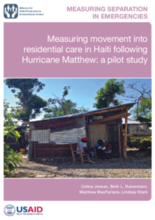Abstract
BACKGROUND:
Governments have an ethical imperative to safeguard children in residential care institutions at all times, including in the aftermath of an emergency. Yet, a lack of accurate data about how the magnitude and characteristics of this population may change due to an emergency impedes leaders' ability to formulate responsive policies and services, mobilize resources and foster accountability. The purpose of this study was therefore to determine the feasibility of evaluating movement of children into residential care following an emergency.
METHODS:
The pilot study took place in Les Cayes commune in the Sud Department of Haiti in April 2017. Six months prior to the pilot, the area was severely affected by Hurricane Matthew, with widespread devastation to property, livestock and livelihoods. Using a two-stage process, the team created a comprehensive list of residential care institutions in Les Cayes. At each facility, the data collectors attempted to administer four separate tools: a group count tool, a record review tool, interviews with staff, and interviews with children 10 years of age and older.
RESULTS:
Out of 27 known institutions in Les Cayes, 22 institutions consented to participate in the research. Within these 22 institutions, the prevalence of new arrivals to residential care since Hurricane Matthew varied significantly across the four tools, ranging from 0.69% according to the aggregated child interviews to 20.96% according to the aggregated staff interviews. Record availability and quality was very poor and child participation was difficult to arrange due to travel and scheduling constraints.
INTERPRETATION:
Robust measurement of new arrivals to residential care institutions was not feasible in Haiti following Hurricane Matthew. Moreover, many of the challenges encountered are likely to be encountered in humanitarian emergencies in other settings. Therefore, the research team does not recommend scale-up of these methods in most humanitarian settings. Alternative approaches that incorporate household survey methods to ascertain movement into residential care based on reports from caregivers may be more realistic in places with poor pre-existing governance systems and weak registries and records for residential care institutions.

